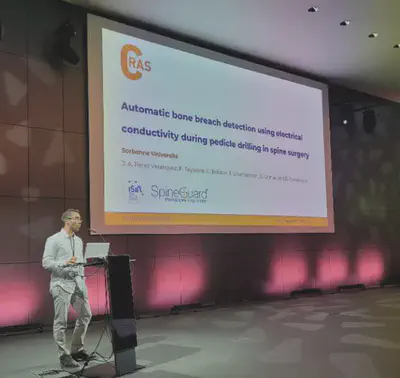SpineGuard's DSG technology applied to robotics: podium presentation of the results at the Conference on New Technologies for Computer and Robot Assisted Surgery (CRAS 2023)
100% of the drillings stopped within a corridor considered as clinically safe, which consists of 2 millimeters on each side of the interface between bone and the spinal canal

PARIS and BOULDER (CO), September 18th, 2023 – 6:00pm CEST - SpineGuard (FR0011464452 – ALSGD), an innovative company that deploys its DSG® (Dynamic Surgical Guidance) sensing technology to secure and streamline the placement of bone implants, announced that a research team presented an article at the CRAS conference on September 12th in Paris, France. They report the progress made with the robotic application of DSG.
Stéphane Bette, co-founder and Deputy CEO of SpineGuard, said:
“The acceptance of this new article in a reference conference of the sector is a new validation by the scientific community of the value and feasibility in using DSG to enhance surgical robots in orthopedics. It also displays the richness of our collaboration with ISIR and the hospital practitioners who contributed to this study.”
Brahim Tamadazte, Research Director at CNRS and member of ISIR (Sorbonne Université, CNRS UMR 7222, Inserm U1150), co-author of the study, adds:
“The tight collaboration between SpineGuard, the Sorbonne Institute of Spine Surgery and ISIR continuously allows for improving Spine Surgery. The know-how combination of SpineGuard for DSG smart instruments with our long-time expertise in surgical robotics and the experience of renown spine surgeons such as Raphaël Vialle, Elie Saghbiny and Christina Bobbio, enabled us to develop an algorithmic method for detecting potential bone breaches during pedicle screw insertion.”
Pr. Roger Widmann, Chief of the Pediatric Orthopedic Surgery, Hospital for Special Surgery, New York, US, and Professor at Weill Cornell Medical College, concludes:
“The innovative and truly unique aspect of DSG technology is that the electrical conductivity data obtained from the tip of the DSG-enhanced surgical drills and taps provides real-time position and guidance information from the tip of traditional robotically navigated surgical instruments. DSG data provides confirmatory secondary modality data and confirmation regarding the 3D location of the instrument tip, and in doing so can help prevent complications and errors related to loss of registration or failure of traditional navigation before creation of pilot hole or definitive screw placement.”
DSG is based on the local measurement of electrical conductivity of tissues in real time without X-ray imaging, with a sensor located at the tip of the drilling instrument. Its efficacy was proven by more than 95,000 surgeries across the globe and 25 scientific publications. SpineGuard has entered in 2017 a collaboration with the ISIR (Institut des Systèmes Intelligents et de Robotique) lab of Sorbonne University, CNRS and INSERM, for the application of DSG to surgical robots and the enhancement of their safety, accuracy, and autonomy.
CRAS (Conference on New Technologies for Computer and Robot Assisted Surgery) founded in 2011 has become one of the most recognized scientific conferences in the field of robot assisted surgery. Its goals are to strengthen the collaboration between the different research groups to boost the efficacy and shorten the development cycle, in a context where numerous technologies applicable to robotics have not made their way into operating rooms yet.
A clinically relevant configuration. The experiment which results were presented, consists in automatically stopping the drill bit as the tip is aiming at the bone boundary during a vertebral drilling performed autonomously by a robot. However, in order to go further in the challenge and the demonstration of DSG efficacy, the trajectory is now pedicular. It presents tangential configurations perfectly matching delicate surgical situations where the spinal canal protecting the spinal cord must be avoided, and where the tip does not coast the bone surface in a perpendicular way. The algorithm used for the detection was tuned before the 50-drilling series was performed, and no adjustments or calibrations are needed for each specimen. The ex vivo pig vertebra validation model (butcher shop) does not involve any animal sacrifice. 100% success, an indisputable result 100% of the drillings stopped within a corridor considered as clinically safe, which consists of 2 millimeters on each side of the interface between bone and the spinal canal. More precisely, all drillings belonged to a -0.9mm/+1.4mm interval, with a mean distance of 0.7mm. This was obtained although the drilling was performed in a totally “blind” manner, with neither utilization of pre-op nor intra-op imaging.
Find out more in the press release here.